20.5 Solving Trigonometric Equations
Solve for Trig Function - Then Angle • Use Algebraic Methods and Trigonometric Identities • Use of Calculator
One of the most important uses of the trigonometric identities is in the solution of equations involving trigonometric functions. The solution of this type of equation consists of the angles that satisfy the equation. When solving for the angle, we generally first solve for a value of a function of the angle and then find the angle from this value of the function.
When equations are written in terms of more than one function, the identities provide a way of changing many of them to equations or factors involving only one function of the same angle. Thus, the solution is found by using algebraic methods and trigonometric identities and values. From Chapter 8, recall that we must be careful regarding the sign of the value of a trigonometric function in finding the angle. Figure 20.26 shows again the quadrants in which the functions are positive. Functions not listed are negative.

Fig. 20.26
EXAMPLE 1 First solve for cos θ
Solve the equation for all values of such that
Solving the equation for we obtain The problem asks for all values of from 0 to that satisfy the equation. We know that the cosines of angles in the first and fourth quadrants are positive. Also, we know that which means that is the reference angle. Therefore, the solution proceeds as follows:
EXAMPLE 2 Use identity—factor—solve for sin x
Solve the equation
By use of the identity this equation may be put in terms of sin x only. Thus, we have
Setting each factor equal to zero, we find or For the domain 0 to gives and gives Therefore,
These values check when substituted in the original equation.
GRAPHICAL SOLUTIONS
As with algebraic equations, graphical solutions of trigonometric equations are approximate, whereas algebraic solutions often give exact solutions. As before, we collect all terms on the left of the equal sign, with zero on the right. We then graph the function on the left to find its zeros by finding the values of x where the graph crosses (or is tangent to) the x-axis.
EXAMPLE 3 Solution using calculator
Graphically solve the equation by using a calculator. (This is the same equation as in Example 2.)
Because all the terms of the equation are on the left, with zero on the right, we now set We then enter this function in the calculator as and the graph is displayed in Fig. 20.27. Using the zero feature of a calculator, we find that for

Fig. 20.27
These values are the same as in Example 2. We note that for the curve touches the x-axis but does not cross it. This means it is tangent to the x-axis.
EXAMPLE 4 Solve—check for extraneous solutions
Solve the equation
By using the half-angle formula for cos (x/2) and then squaring both sides of the resulting equation, this equation can be solved:
CAUTION
In finding this solution, we squared both sides of the original equation. In doing this, we may have introduced extraneous solutions (see Section 14.3). Thus, we must check each solution in the original equation to see if it is valid.
Hence,
Thus, the apparent solution is not a solution of the original equation. The correct solutions are and We can see that these values agree with the values of x for which the graph of crosses the x-axis in Fig. 20.28.

Fig. 20.28
EXAMPLE 5 Trig equation—spring displacement
The vertical displacement y of an object at the end of a spring, which itself is being moved up and down, is given by Find the first two values of t (in seconds) for which
Using the double-angle formula for sin 2t leads to the solution.
Because cos t cannot be numerically larger than 1, there are no values of t for which Thus, the required times are
We can see that these values agree with the values of t for which the graph of crosses the t-axis in Fig. 20.29. (In using a graphing calculator, use x for t.)
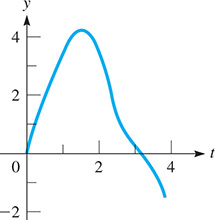
Fig. 20.29
EXAMPLE 6 Solve for 2θ—then θ
Solve the equation
For we must have values of such that Therefore,
This means that the solutions are
These values satisfy the original equation. Because we multiplied through by in the solution, any value of that leads to would not be valid, because this would indicate division by zero in the original equation.
We see that these solutions agree with the values of for which the graph of crosses the in Fig. 20.30. (In using a graphing calculator, use x for
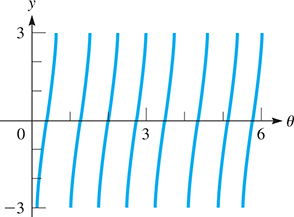
Fig. 20.30
EXAMPLE 7 Recognize trigonometric form—solve
Solve the equation
The left side of this equation is of the general form where Therefore,
The original equation becomes
This equation is satisfied if or The solutions are and Only through recognition of the proper trigonometric form can we readily solve this equation.
We see that these solutions agree with the two values of x for which the graph of touches the x-axis in Fig. 20.31.
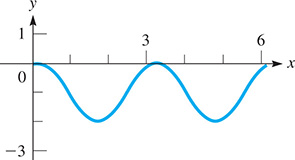
Fig. 20.31
EXAMPLE 8 Solve using calculator—height of tsunami wave
Aerial photographs and computer analysis show that a certain tsunami wave could be represented as where y (in m) is the height of the wave for a horizontal displacement x (in m). Find the height of the peak of the wave and the displacement x for the peak.
Entering the function in the calculator as the graph is shown in Fig. 20.32. We can find the coordinates of the peak of the wave using the maximum feature, as shown in the display. Thus, the peak of the wave is 31.7 m when
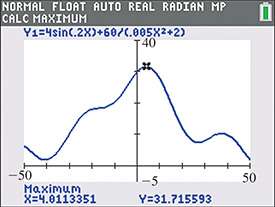
Fig. 20.32
EXERCISES 20.5
In Exercises 1–4, make the given changes in the indicated examples of this section and then solve the resulting problems.
In Example 1, change to
In Example 2, change to
In Example 4, change to and on the right of the equal sign change the to
In Example 7, change the to
In Exercises 5–20, solve the given trigonometric equations analytically (using identities when necessary for exact values when possible) for values of x for
In Exercises 21–38, solve the given trigonometric equations analytically and by use of a calculator. Compare results. Use values of x for
In Exercises 39–54, solve the indicated equations analytically.
[Hint: See Eq. (20.17).]
[Hint: See Eq. (20.20).]
Is there any positive acute angle for which Explain.
Use a calculator to determine the minimum value of the function to the left of the equal sign in Exercise 41 (for a positive acute angle).
Solve the system of equations for
Solve the system of equations for
Find the angles of a triangle if one side is twice another side and the angles opposite these sides differ by .
If two musical tones of frequencies 220 Hz and 223 Hz are played together, beats will be heard. This can be represented by Graph this function and estimate t (in s) when between beats for
The acceleration due to gravity g (in ) varies with latitude, approximately given by where is the latitude in degrees. Find for
Under certain conditions, the electric current i (in A) in the circuit shown in Fig. 20.33 is given below. For what value of t (in s) is the current first equal to zero?
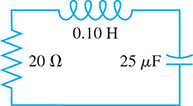
Fig. 20.33
The vertical displacement y (in m) of the end of a robot arm is given by Find the first four values of t (in s) for which
In finding the maximum illuminance from a point source of light, it is necessary to solve the equation Find if
To find the angle subtended by a certain object on a camera film, it is necessary to solve the equation where p is the distance from the camera to the object. Find if
The velocity of a certain piston is maximum when the acute crank angle satisfies the equation Find this angle.
Resolve a force of 500.0 N into two components, perpendicular to each other, for which the sum of their magnitudes is 700.0 N, by using the angle between a component and the resultant.
Looking for a lost ship in the North Atlantic Ocean, a plane flew from Reykjavik, Iceland, 160 km west. It then turned and flew due north and then made a final turn to fly directly back to Reykjavik. If the total distance flown was 480 km, how long were the final two legs of the flight? Solve by setting up and solving an appropriate trigonometric equation. (The Pythagorean theorem may be used only as a check.)
In Exercises 55–62, solve the given equations graphically.
In finding the frequencies of vibration of a vibrating wire, the equation occurs. Find x if
An equation used in astronomy is Solve for for and
